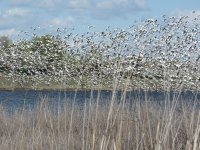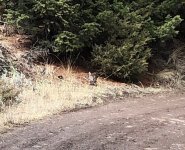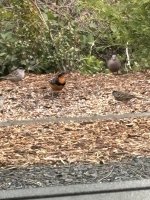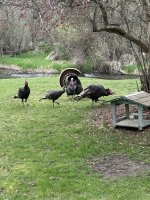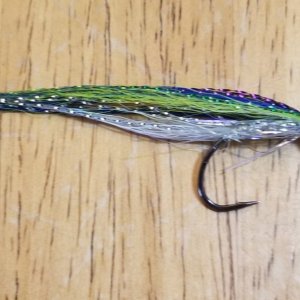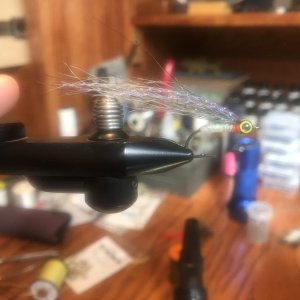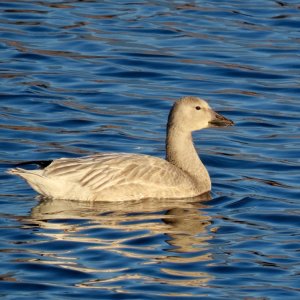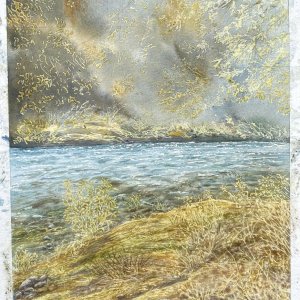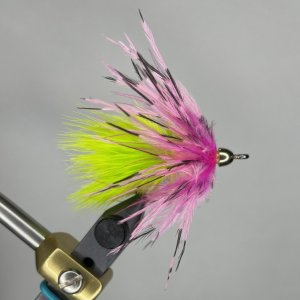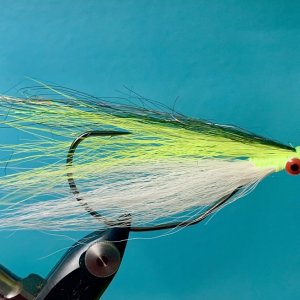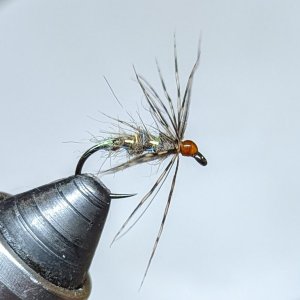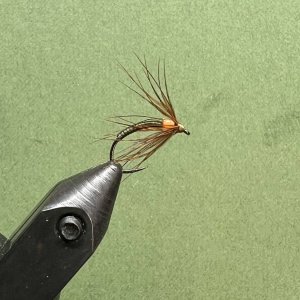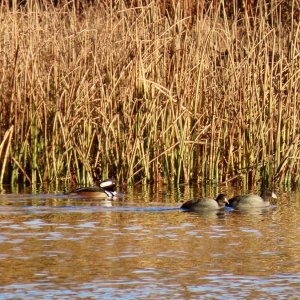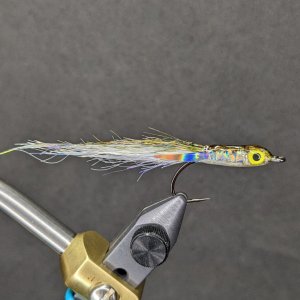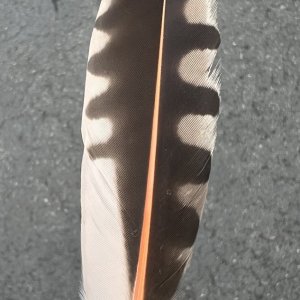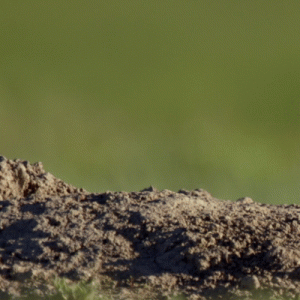I think it is highly variable depending on exact location. I have seen a bunch of Green Wing Teal this spring, and there are lots of shorebirds ( Avocets, Stilts, Phaloropes, dunlon and sandpipers, sometimes white-faced Ibis)) at Clover Island and the Millet Ponds at Wallula in the spring but I don’t see them in fall.It is interesting to me how the migration patterns vary as far as what shows up in spring vs fall. I never see shorebirds in the spring, but get a variety of sandpipers, yellow legs, etc. in the late summer. Cinnamon Teals and Shovelers are spring only, but Green Wing and Blue-winged Teals only appear in the fall. Wood Ducks can be either. Anyway, today a couple pairs of Shovelers decided to spend the day resting here.View attachment 110415
You are using an out of date browser. It may not display this or other websites correctly.
You should upgrade or use an alternative browser.
You should upgrade or use an alternative browser.
Got any bird pics?
- Thread starter Wadin' Boot
- Start date
My wife and I spent the last week in March, her quarter break, exploring Joshua Tree National Park, the Salton Sea, and Anza Borego State Park. The wildflowers were excellent and we had great looks at many desert birds, lizards, insects, and even mammals. I ended up with 3100 pictures that I have been processing for the last two weeks. So, expect multiple contributions over the next few days.
One of the highlights of the trip was an opportunity for my wife to see burrowing owls, a lifer for her. I had seen them along the fields at the south end of the Salton Sea in the mid-80’s. But I had heard that changes in agricultural practices there had impacted their numbers. When we stopped at the Sony Bono Salton Sea Wildlife Refuge, a very helpful volunteer mapped out several gravel farm roads that had a high chance of hosting burrowing owls. Her advice was to drive slowly along specific road sections and just use the car as a blind. Her advice was spot-on as we began to see birds right where she had predicted. In the end, we saw at least 15 individuals along a few miles of road.
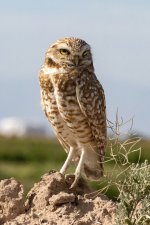
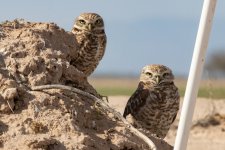
They were typically 20-30’ away from the rental car and pretty nonplussed by our presence. I had the impression that the owls were “aggregated” – not randomly or “regularly” distributed. These loose aggregations of owls have been observed in other areas.
In the late afternoon, most birds were perched on the tops of dried mud piles between the gravel road and the fields.

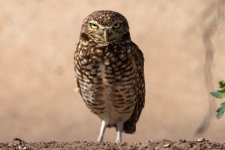
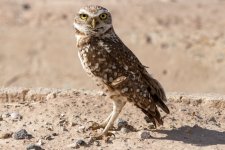
A few individuals perched on irrigation equipment to gain a bit more elevation. These are small owls, about 8-10” in height with long legs for their body size and weigh about 6oz. They are opportunistic predators, and I expect that there are diverse prey (insects, rodents, small birds, frogs, etc.) for them to run down (common feeding strategy) in this area.
In a few cases, the birds were at the edges of mud burrows – an atypical nesting location for an owl.
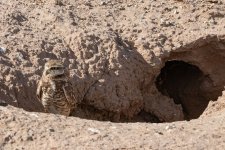
While there is some evidence that burrowing owls can dig their own burrows (especially in Florida and the Caribbean), they can also use the burrows of prairie dogs and other large rodents. During our search, we encountered on round-tailed ground squirrel in a lookout position at the top of a mud mound.
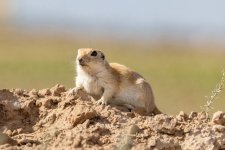
Very cool.
Steve
One of the highlights of the trip was an opportunity for my wife to see burrowing owls, a lifer for her. I had seen them along the fields at the south end of the Salton Sea in the mid-80’s. But I had heard that changes in agricultural practices there had impacted their numbers. When we stopped at the Sony Bono Salton Sea Wildlife Refuge, a very helpful volunteer mapped out several gravel farm roads that had a high chance of hosting burrowing owls. Her advice was to drive slowly along specific road sections and just use the car as a blind. Her advice was spot-on as we began to see birds right where she had predicted. In the end, we saw at least 15 individuals along a few miles of road.


They were typically 20-30’ away from the rental car and pretty nonplussed by our presence. I had the impression that the owls were “aggregated” – not randomly or “regularly” distributed. These loose aggregations of owls have been observed in other areas.
In the late afternoon, most birds were perched on the tops of dried mud piles between the gravel road and the fields.



A few individuals perched on irrigation equipment to gain a bit more elevation. These are small owls, about 8-10” in height with long legs for their body size and weigh about 6oz. They are opportunistic predators, and I expect that there are diverse prey (insects, rodents, small birds, frogs, etc.) for them to run down (common feeding strategy) in this area.
In a few cases, the birds were at the edges of mud burrows – an atypical nesting location for an owl.

While there is some evidence that burrowing owls can dig their own burrows (especially in Florida and the Caribbean), they can also use the burrows of prairie dogs and other large rodents. During our search, we encountered on round-tailed ground squirrel in a lookout position at the top of a mud mound.

Very cool.
Steve
tkww
Steelhead
Indeed, I it seems to be very much an exact location thing. I should have been more clear about that. I see the ebird reports and alerts, so I know many of those birds are around. I just find it interesting how seemingly consistent the differences are in my location (Walla Walla).I think it is highly variable depending on exact location. I have seen a bunch of Green Wing Teal this spring, and there are lots of shorebirds ( Avocets, Stilts, Phaloropes, dunlon and sandpipers, sometimes white-faced Ibis)) at Clover Island and the Millet Ponds at Wallula in the spring but I don’t see them in fall.
Divad
Whitefish
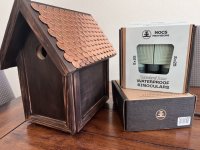
Well it’s pretty much done! The burned look came out really good and might put a penny at the roof apex on the front to blend in the theme. Most likely won’t get used until next year as I guess Wrens and Chickadees search out their nest sites in March/April. Pennies should dull up by then too.
The binoculars are quite nice for the price and the no hassle warranty was the selling point. Plus cool colors for kids. Gifting it next weekend!
Most of the waterfowl is thinning out in the mid-Columbia as they head to their summer homes. Some stay around all summer, and our Ospreys came back a couple of weeks ago.
Double- Crested Cormorant
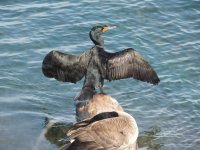
Peregrine- year round resident
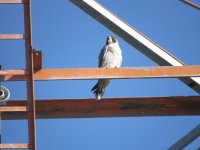
Osprey
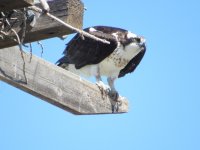
Red Heads
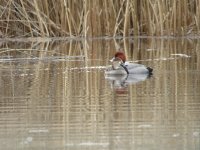
Snow Geese- still a few around
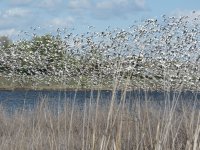
Barrow's Goldeneye
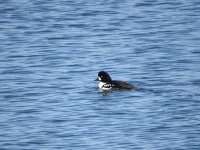
Double- Crested Cormorant

Peregrine- year round resident

Osprey

Red Heads

Snow Geese- still a few around

Barrow's Goldeneye

Attachments
Cabezon:
Ya gotta love those owls. I have seen them at Malheur.
Rich:
Very nice, as usual.
Thanks.
Ya gotta love those owls. I have seen them at Malheur.
Rich:
Very nice, as usual.
Thanks.
Our trip to Joshua Tree, Anza Borrego, and the Salton Sea at the end of March was very productive for birds – 82 species. No lifers for me, but I’ve been birding this area since the mid-80’s. I’m happy just to have great looks at familiar birds, especially birds engaged in their normal behavior. When I think of birding in the SoCal deserts, I think of four species: great roadrunner, cactus wren, rock wren, and phainopepla. [Yes, I also think of orioles and tanagers, but they did not show this trip.]
We had my best-ever look at a semi-tame greater roadrunner. This bird’s territory included a pair of picnic tables outside the Visitor Center at Borrego Springs. Its game was to dash up to a recently vacated picnic table to see if any scraps had fallen on the ground. So, it isn’t intimidated by humans. Greater roadrunners are known opportunistic feeders. And we had great views of this bird with full-screen images. More typically, our other encounters with greater roadrunners on this trip consisted of brief view of birds dashing across the road in front of the car. No coyotes or “meep, meep” sounds were heard.
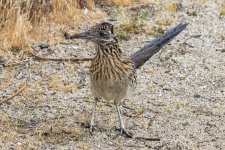
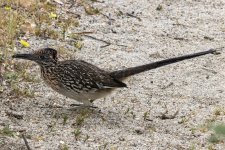
Cactus wren produce a very distinctive raspy “char, char, char, char” song that carries quite far in the desert. So, we knew when they were around, but catching sight of a bird would be a bigger challenge. But I spied a bird foraging on the ground at Salton Sea State Recreation Area. It was near the campground and I think that birds that encounter humans regularly are likely to be more comfortable around us.
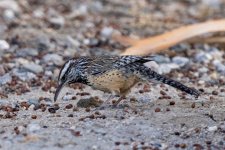
Our second quality encounter occurred while bushwacking in Anza Borrego. This cactus wren decided to live up to the stereotype and started singing while perched on an ocotillo branch.
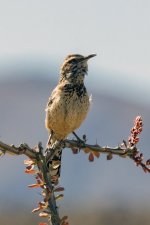
We heard rock wrens quite often during our hikes in Joshua Tree and Anza Borrego (and canyon wrens too). But catching sight of them was a different story. On an afternoon hike around Cap Rock in JT, we caught one bird singing its distinctive song as he marked his territory.
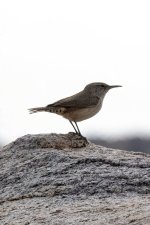
Later, in Anza Borrego, we caught another rock wren foraging in some desert shrubs.
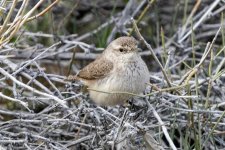
Our final iconic desert bird is the phainopepla. The males have satin-black feathers and both sexes have bright red eyes. We saw birds perched in the open several times, but never too close. If I was quick, I could snap a shot or two before the bird disappeared into deeper cover. They are omnivores with a sweet tooth for mistletoe berries.
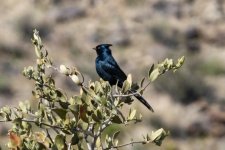
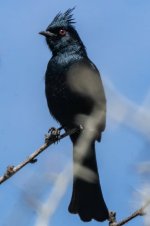
Steve
We had my best-ever look at a semi-tame greater roadrunner. This bird’s territory included a pair of picnic tables outside the Visitor Center at Borrego Springs. Its game was to dash up to a recently vacated picnic table to see if any scraps had fallen on the ground. So, it isn’t intimidated by humans. Greater roadrunners are known opportunistic feeders. And we had great views of this bird with full-screen images. More typically, our other encounters with greater roadrunners on this trip consisted of brief view of birds dashing across the road in front of the car. No coyotes or “meep, meep” sounds were heard.


Cactus wren produce a very distinctive raspy “char, char, char, char” song that carries quite far in the desert. So, we knew when they were around, but catching sight of a bird would be a bigger challenge. But I spied a bird foraging on the ground at Salton Sea State Recreation Area. It was near the campground and I think that birds that encounter humans regularly are likely to be more comfortable around us.

Our second quality encounter occurred while bushwacking in Anza Borrego. This cactus wren decided to live up to the stereotype and started singing while perched on an ocotillo branch.

We heard rock wrens quite often during our hikes in Joshua Tree and Anza Borrego (and canyon wrens too). But catching sight of them was a different story. On an afternoon hike around Cap Rock in JT, we caught one bird singing its distinctive song as he marked his territory.

Later, in Anza Borrego, we caught another rock wren foraging in some desert shrubs.

Our final iconic desert bird is the phainopepla. The males have satin-black feathers and both sexes have bright red eyes. We saw birds perched in the open several times, but never too close. If I was quick, I could snap a shot or two before the bird disappeared into deeper cover. They are omnivores with a sweet tooth for mistletoe berries.


Steve
Game birds: Doves and Quail
The SoCal deserts have a rich dove/pigeon diversity. We saw six species and could have picked up one or two more if we did some additional digging. Of course, one common species that we saw was the mourning dove. I think that it is a cruel trick that the target of the upland bird season (typically Labor Day weekend) is the morning dove, one of the most elusive species. It is almost as if the season setters have stock in shotgun shell companies and wish hunters to shoot so many shells that they have to reorder while still in the first week of the season and their skils are rusty. Of course, March is quite a long time from the hunting season and the birds that we saw were far more relaxed – more interested in pairing up and starting to nest.
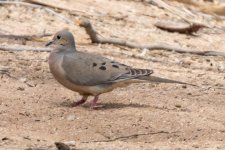
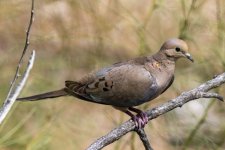
The Visitor Center at the Sonny Bono Salton Sea National Wildlife Refuge has a bird feeder. Among the many species attracted to a free meal were several common ground doves. They are North America’s smallest dove (about the size of a song sparrow), about a quarter the size of the mourning dove to the right of it. In flight, their wings flash red-brown.
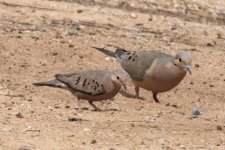
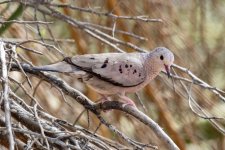
At Anza Borrego, white-winged doves are quite common. We often heard males singing their repeated hooting coos from exposed perches. Their wings also produce a distinctive sound when they fly off. This is a species whose range has expanded due to human farming activities. Its home range before the expansion of agriculture was the Sonoran Desert where they relied heavily of saguaro cactus. Like the extinct passenger pigeon, they used to nest in large colonies, but most nesting is now done in much smaller groups.
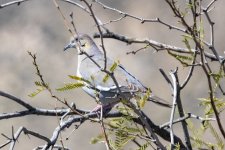
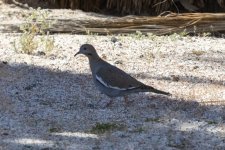
The last dove species that I photographed (rock doves don’t make the cut and the band-tailed pigeons rocketed overhead without a chance for a photograph) is a relatively new arrival, the Eurasian collared dove. While not migratory, they are dispersive. Starting from a population of less than 50 birds that escape captivity in Nassau in 1974, they have now spread cross North America. In newly-colonized areas, their populations can expand quickly, but in area where they are well-established, their populations are stable, even possibly decreasing.
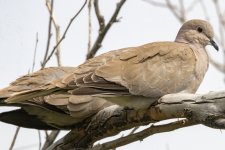
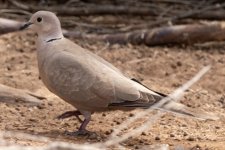
We saw / heard both Gambel’s quail and California quail on our hikes. While the hens scrambled to stay in cover, the males appeared to be of two minds. Yes, they were wary of us, but they just had perch in a prominent location and sing out. That age-old conflict between self-preservation and self-promotion…
California quail
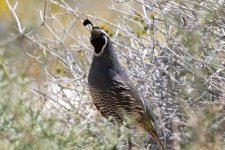
Gambel's quail
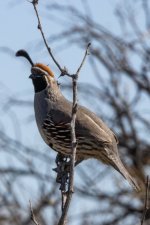
Steve
The SoCal deserts have a rich dove/pigeon diversity. We saw six species and could have picked up one or two more if we did some additional digging. Of course, one common species that we saw was the mourning dove. I think that it is a cruel trick that the target of the upland bird season (typically Labor Day weekend) is the morning dove, one of the most elusive species. It is almost as if the season setters have stock in shotgun shell companies and wish hunters to shoot so many shells that they have to reorder while still in the first week of the season and their skils are rusty. Of course, March is quite a long time from the hunting season and the birds that we saw were far more relaxed – more interested in pairing up and starting to nest.


The Visitor Center at the Sonny Bono Salton Sea National Wildlife Refuge has a bird feeder. Among the many species attracted to a free meal were several common ground doves. They are North America’s smallest dove (about the size of a song sparrow), about a quarter the size of the mourning dove to the right of it. In flight, their wings flash red-brown.


At Anza Borrego, white-winged doves are quite common. We often heard males singing their repeated hooting coos from exposed perches. Their wings also produce a distinctive sound when they fly off. This is a species whose range has expanded due to human farming activities. Its home range before the expansion of agriculture was the Sonoran Desert where they relied heavily of saguaro cactus. Like the extinct passenger pigeon, they used to nest in large colonies, but most nesting is now done in much smaller groups.


The last dove species that I photographed (rock doves don’t make the cut and the band-tailed pigeons rocketed overhead without a chance for a photograph) is a relatively new arrival, the Eurasian collared dove. While not migratory, they are dispersive. Starting from a population of less than 50 birds that escape captivity in Nassau in 1974, they have now spread cross North America. In newly-colonized areas, their populations can expand quickly, but in area where they are well-established, their populations are stable, even possibly decreasing.


We saw / heard both Gambel’s quail and California quail on our hikes. While the hens scrambled to stay in cover, the males appeared to be of two minds. Yes, they were wary of us, but they just had perch in a prominent location and sing out. That age-old conflict between self-preservation and self-promotion…
California quail

Gambel's quail

Steve
Bonefish Jack
Steelhead
Insectivores:
With a wet winter and spring producing lush foliage and blooms in Joshua Tree and Anza Borrego, insect populations explode. This provided a bonanza for insectivorous birds. Always in motion, they can be a challenge to capture with a camera. We saw two old friends that are straight-forward to identify: black phoebe
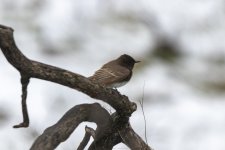
And a Say’s Phoebe perched on an old yucca bloom
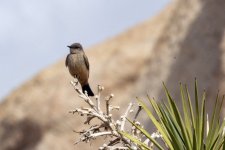
But we also encountered a somewhat-unexpected flycatcher, one of the Empidonax flycatcher group. The differences among these species are subtle (and often best identified by sound), but this is probably a Western flycatcher.
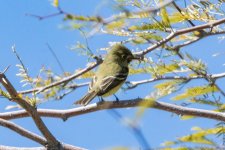
As expected, we also encountered some distinctive desert insectivores. We would hear a buzzing hissing, scolds from the shrubs and if we were patient, the caller would reveal itself - a black-tailed gnatcatcher.
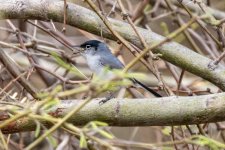
At one point, a male perched on a branch and broke into its warbling song.
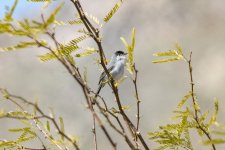
On several hikes, we also encountered verdins with their yellow heads. These are the desert equivalent of bushtits (but forage as individuals, not in groups). These are the only North American representative of a family that is more common in Eurasia and Africa. Like bushtits, they are rarely still, constantly searching among shrubs for an insect meal. Both of these pictures are birds on a creosote bush.
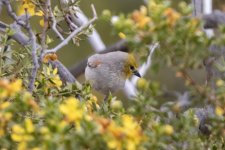
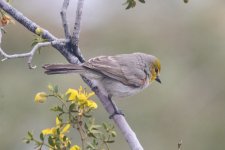
Like snowbirds, some bird species find refuge in the California deserts to escape winter conditions in their breeding grounds. One common insectivorous refugee is the yellow-rumped warbler. We commonly saw them gleaning insects from the canopy of taller shrubs.
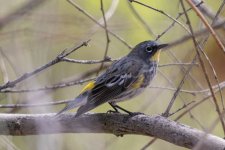
Less commonly seen from deeper in the foliage, we also saw several female yellow warblers.
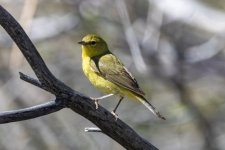
Steve
With a wet winter and spring producing lush foliage and blooms in Joshua Tree and Anza Borrego, insect populations explode. This provided a bonanza for insectivorous birds. Always in motion, they can be a challenge to capture with a camera. We saw two old friends that are straight-forward to identify: black phoebe

And a Say’s Phoebe perched on an old yucca bloom

But we also encountered a somewhat-unexpected flycatcher, one of the Empidonax flycatcher group. The differences among these species are subtle (and often best identified by sound), but this is probably a Western flycatcher.

As expected, we also encountered some distinctive desert insectivores. We would hear a buzzing hissing, scolds from the shrubs and if we were patient, the caller would reveal itself - a black-tailed gnatcatcher.

At one point, a male perched on a branch and broke into its warbling song.

On several hikes, we also encountered verdins with their yellow heads. These are the desert equivalent of bushtits (but forage as individuals, not in groups). These are the only North American representative of a family that is more common in Eurasia and Africa. Like bushtits, they are rarely still, constantly searching among shrubs for an insect meal. Both of these pictures are birds on a creosote bush.


Like snowbirds, some bird species find refuge in the California deserts to escape winter conditions in their breeding grounds. One common insectivorous refugee is the yellow-rumped warbler. We commonly saw them gleaning insects from the canopy of taller shrubs.

Less commonly seen from deeper in the foliage, we also saw several female yellow warblers.

Steve
Simply outstanding, Steve, the whole series!
Thanks much for sharing,
Kenneth
Thanks much for sharing,
Kenneth
Sparrows and finches
The deserts of the Southern California have a diverse group of sparrows and finches, especially in a wet winter/spring stimulating an explosion of annuals. And many of these birds are very distinctive (and one is not…). One of the most colorful is the black-throated sparrow. We encountered them as single or pairs several times in Joshua Tree and in Anza Borrego. They are one of my favorite sparrows.
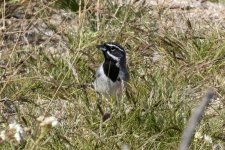
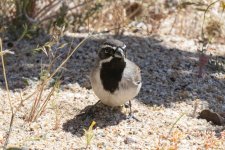
On our last day in Anza Borrego, I had made a quick stop to take some additional pictures of desert lilies. As it was a quick stop, I left my telephoto in the car. And of course, I spotted another sparrow species that we hadn’t seen before – the world is like that …. So, I sprinted back to the car, grabbed the camera and Amy, and we made it back before the birds disappeared. They were a pair of lark sparrows, gorgeous birds.
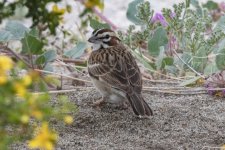
[This bird below was sheltering under a flowering creosote bush from a light rain squall.]
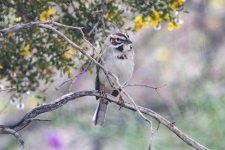
At the other end of the distinctive spectrum are Brewer’s sparrows. As a biologist, I have often had to use biological keys (dichotomous keys) to identify organisms. These are organized into couplets kind of like “1a. has eight limbs, go to step X (Arachnid) or 1b. has six limbs, go to step Y (Insect)”. The designers of these keys are relying on unique combinations of features that one species has that will allow you to put a name on that species.
For both the black-throated sparrow and lark sparrow, you wouldn’t have to go through many couplets to end up at the right species; they have very remarkable plumages. But for Brewers sparrows, you would reach the end of the key and the second part of the final couplet would be “no distinctive features, Brewer’s sparrow”. In Cornell’s All About Birds web site, they include this statement: ‘In 1923, the naturalist William Dawson wrote that Nature had “done her utmost to produce a bird of non-committal appearance… Mere brown might have been conspicuous by default, but brownish, broken up by hazy streakings of other brownish or dusky… has given us a bird which… may be said to have no mark of distinction whatever—just bird.”’
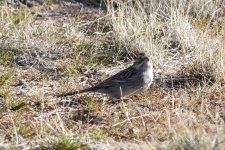
And yet while the plumage of the birds themselves might be “subtle”, a flock of these birds makes a distinctive “tinkling” calls to maintain flock cohesion. Singing males resemble the songs of canaries.
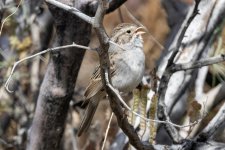
Among the tiny Brewer’s sparrow (0.3oz.), there would occasionally be the relatively massive white-crowned sparrows (1oz.).
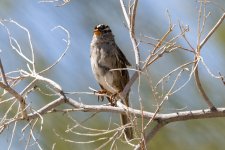
We also encountered several species of finches. House finches, especially males, are a very bright birds to see in the desert. These birds acquire the pigments that are incorporated in the feathers comes from their diet. Therefore, a male that is eating well will have a bright red head and neck, like this male on a yucca branch.
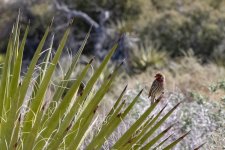
And the females, like this one perched on a jumping cholla branch, really like the guys with the brightest coloration.
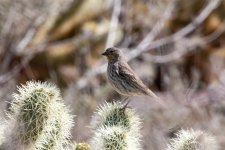
We also encountered lesser goldfinches, like this male. In the spring, they are a fan of flowers.
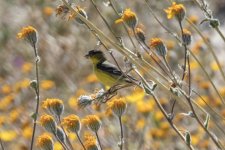
Steve
The deserts of the Southern California have a diverse group of sparrows and finches, especially in a wet winter/spring stimulating an explosion of annuals. And many of these birds are very distinctive (and one is not…). One of the most colorful is the black-throated sparrow. We encountered them as single or pairs several times in Joshua Tree and in Anza Borrego. They are one of my favorite sparrows.


On our last day in Anza Borrego, I had made a quick stop to take some additional pictures of desert lilies. As it was a quick stop, I left my telephoto in the car. And of course, I spotted another sparrow species that we hadn’t seen before – the world is like that …. So, I sprinted back to the car, grabbed the camera and Amy, and we made it back before the birds disappeared. They were a pair of lark sparrows, gorgeous birds.

[This bird below was sheltering under a flowering creosote bush from a light rain squall.]

At the other end of the distinctive spectrum are Brewer’s sparrows. As a biologist, I have often had to use biological keys (dichotomous keys) to identify organisms. These are organized into couplets kind of like “1a. has eight limbs, go to step X (Arachnid) or 1b. has six limbs, go to step Y (Insect)”. The designers of these keys are relying on unique combinations of features that one species has that will allow you to put a name on that species.
For both the black-throated sparrow and lark sparrow, you wouldn’t have to go through many couplets to end up at the right species; they have very remarkable plumages. But for Brewers sparrows, you would reach the end of the key and the second part of the final couplet would be “no distinctive features, Brewer’s sparrow”. In Cornell’s All About Birds web site, they include this statement: ‘In 1923, the naturalist William Dawson wrote that Nature had “done her utmost to produce a bird of non-committal appearance… Mere brown might have been conspicuous by default, but brownish, broken up by hazy streakings of other brownish or dusky… has given us a bird which… may be said to have no mark of distinction whatever—just bird.”’

And yet while the plumage of the birds themselves might be “subtle”, a flock of these birds makes a distinctive “tinkling” calls to maintain flock cohesion. Singing males resemble the songs of canaries.

Among the tiny Brewer’s sparrow (0.3oz.), there would occasionally be the relatively massive white-crowned sparrows (1oz.).

We also encountered several species of finches. House finches, especially males, are a very bright birds to see in the desert. These birds acquire the pigments that are incorporated in the feathers comes from their diet. Therefore, a male that is eating well will have a bright red head and neck, like this male on a yucca branch.

And the females, like this one perched on a jumping cholla branch, really like the guys with the brightest coloration.

We also encountered lesser goldfinches, like this male. In the spring, they are a fan of flowers.

Steve
Great reports, Steve! I've been a big fan of the black-throated sparrow ever since I was taught that its call is the theme song to the Austin Powers movies. I have to smile every time I hear one. (https://xeno-canto.org/explore?query=black-throated sparrow)
This was taken in Tucson Easter weekend.

This was taken in Tucson Easter weekend.

Water birds
The present incarnation of the Salton Sea is a sewer, a hypersaline (44ppt vs. 35ppt in the ocean) mélange of agricultural pesticides and fertilizers and heavy metals like selenium. Dust from the lake shore that is kicked up by high winds are a respiratory health hazard to those who live along its shores. Everyone agrees that something needs to be done, but selecting a solution (and paying the astronomical bill) has pushed off any attempts at a solution. The lake used to be freshwater, then became more and more saline, and now is saltier than the ocean. Some single-celled algae and bacteria thrive on the high nutrients. Barnacles and salt-tolerant tilapia fish still persist in the lake but their numbers are greatly depressed, especially when blooms of algae and bacteria deplete the oxygen levels in parts of the lake.
And yet, the wetlands that flow into the Salton Sea are a major resource for many bird species. At least 270 species use the Salton Sea area regularly and for some of these species, the Salton Sea is a significant overwintering area for the bulk of their population.
So, we spent a day exploring the wildlife around the shores of the Salton Sea and encountered a number of waterbirds: shorebirds, ducks, and skimmers.
Among the waterbirds were two plovers: a statuesque killdeer
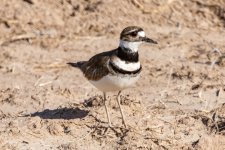
And a black-bellied plover that was still in its non-breeding plumage. This bird was probing for flies among the barnacle shells that litter the shore (and cover the rocks) of the Salton Sea.
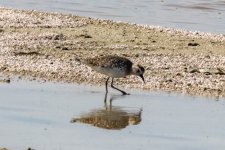
There were several shorebirds and ducks in a small impoundment (Varner Harbor) at Salton Sea State Recreational Area. This harbor used to be a way to launch boats for fishing the Salton Sea, but the water level has dropped so low that the canal leading to the sea is high and dry.
Several black-necked stilts were relaxing on the float by the launch.
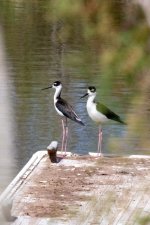
Later, they flew to the canal exiting the harbor to probe the mud for food.
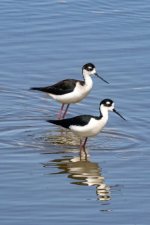
I was somewhat surprised to see a long sandpiperish bird in the harbor area. I debated back and forth what it was, especially with such a long bill, considering whimbrel, godwit, curlew, etc. in large part because the bird was by itself. None of these fit and I started to lean toward dowitcher (though I have never encountered a solo bird). Then, the question was long-billed vs. short-billed. In the end, I have leaned toward short-billed dowitcher.
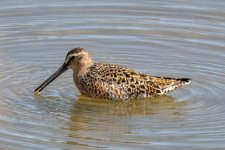
While circling the harbor, we heard the distinctive “weet-weet-weet” call of a spotted sandpiper. We careful scanning of the banks of the harbor and finally picked it out.
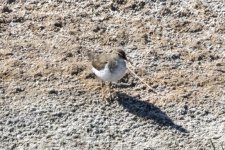
The harbor also had several duck species, including several ruddy ducks, several cinnamon teals, several blue-winged teals,
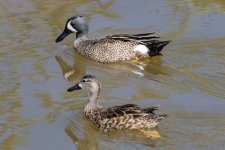
two pairs of Northern shovelers,
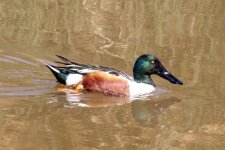
And several scaup.
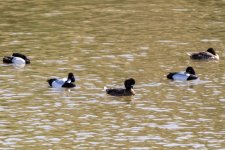
Finally, in the afternoon, we hiked out to a large impoundment that was quite diverse (but most birds in binoc range). These included, white pelicans, double-crested cormorants, a white-faced ibis, American avocets, a willet, several common (?) terns, Northern shovelers, cinnamon teals, and mallards. The prize for me was a black skimmer. Apparently, they were more common here when the fish populations in the Salton Sea were healthier. But it was still great to see this bird flying low and slow over the impoundments surface with its lower bill running right at the water’s surface.
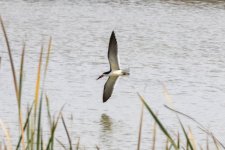
Steve
The present incarnation of the Salton Sea is a sewer, a hypersaline (44ppt vs. 35ppt in the ocean) mélange of agricultural pesticides and fertilizers and heavy metals like selenium. Dust from the lake shore that is kicked up by high winds are a respiratory health hazard to those who live along its shores. Everyone agrees that something needs to be done, but selecting a solution (and paying the astronomical bill) has pushed off any attempts at a solution. The lake used to be freshwater, then became more and more saline, and now is saltier than the ocean. Some single-celled algae and bacteria thrive on the high nutrients. Barnacles and salt-tolerant tilapia fish still persist in the lake but their numbers are greatly depressed, especially when blooms of algae and bacteria deplete the oxygen levels in parts of the lake.
And yet, the wetlands that flow into the Salton Sea are a major resource for many bird species. At least 270 species use the Salton Sea area regularly and for some of these species, the Salton Sea is a significant overwintering area for the bulk of their population.
So, we spent a day exploring the wildlife around the shores of the Salton Sea and encountered a number of waterbirds: shorebirds, ducks, and skimmers.
Among the waterbirds were two plovers: a statuesque killdeer

And a black-bellied plover that was still in its non-breeding plumage. This bird was probing for flies among the barnacle shells that litter the shore (and cover the rocks) of the Salton Sea.

There were several shorebirds and ducks in a small impoundment (Varner Harbor) at Salton Sea State Recreational Area. This harbor used to be a way to launch boats for fishing the Salton Sea, but the water level has dropped so low that the canal leading to the sea is high and dry.
Several black-necked stilts were relaxing on the float by the launch.

Later, they flew to the canal exiting the harbor to probe the mud for food.

I was somewhat surprised to see a long sandpiperish bird in the harbor area. I debated back and forth what it was, especially with such a long bill, considering whimbrel, godwit, curlew, etc. in large part because the bird was by itself. None of these fit and I started to lean toward dowitcher (though I have never encountered a solo bird). Then, the question was long-billed vs. short-billed. In the end, I have leaned toward short-billed dowitcher.

While circling the harbor, we heard the distinctive “weet-weet-weet” call of a spotted sandpiper. We careful scanning of the banks of the harbor and finally picked it out.

The harbor also had several duck species, including several ruddy ducks, several cinnamon teals, several blue-winged teals,

two pairs of Northern shovelers,

And several scaup.

Finally, in the afternoon, we hiked out to a large impoundment that was quite diverse (but most birds in binoc range). These included, white pelicans, double-crested cormorants, a white-faced ibis, American avocets, a willet, several common (?) terns, Northern shovelers, cinnamon teals, and mallards. The prize for me was a black skimmer. Apparently, they were more common here when the fish populations in the Salton Sea were healthier. But it was still great to see this bird flying low and slow over the impoundments surface with its lower bill running right at the water’s surface.

Steve
That is a strange place, and it stinks......
Nice on the birds though!
Nice on the birds though!
joefromchicago
Steelhead
Also interesting to note that heavy rains earlier raised the water level to where it was navigable by kayaks for a short time. Great pics.Water birds
The present incarnation of the Salton Sea is a sewer, a hypersaline (44ppt vs. 35ppt in the ocean) mélange of agricultural pesticides and fertilizers and heavy metals like selenium. Dust from the lake shore that is kicked up by high winds are a respiratory health hazard to those who live along its shores. Everyone agrees that something needs to be done, but selecting a solution (and paying the astronomical bill) has pushed off any attempts at a solution. The lake used to be freshwater, then became more and more saline, and now is saltier than the ocean. Some single-celled algae and bacteria thrive on the high nutrients. Barnacles and salt-tolerant tilapia fish still persist in the lake but their numbers are greatly depressed, especially when blooms of algae and bacteria deplete the oxygen levels in parts of the lake.
And yet, the wetlands that flow into the Salton Sea are a major resource for many bird species. At least 270 species use the Salton Sea area regularly and for some of these species, the Salton Sea is a significant overwintering area for the bulk of their population.
So, we spent a day exploring the wildlife around the shores of the Salton Sea and encountered a number of waterbirds: shorebirds, ducks, and skimmers.
Among the waterbirds were two plovers: a statuesque killdeer
View attachment 111155
And a black-bellied plover that was still in its non-breeding plumage. This bird was probing for flies among the barnacle shells that litter the shore (and cover the rocks) of the Salton Sea.
View attachment 111156
There were several shorebirds and ducks in a small impoundment (Varner Harbor) at Salton Sea State Recreational Area. This harbor used to be a way to launch boats for fishing the Salton Sea, but the water level has dropped so low that the canal leading to the sea is high and dry.
Several black-necked stilts were relaxing on the float by the launch.
View attachment 111157
Later, they flew to the canal exiting the harbor to probe the mud for food.
View attachment 111158
I was somewhat surprised to see a long sandpiperish bird in the harbor area. I debated back and forth what it was, especially with such a long bill, considering whimbrel, godwit, curlew, etc. in large part because the bird was by itself. None of these fit and I started to lean toward dowitcher (though I have never encountered a solo bird). Then, the question was long-billed vs. short-billed. In the end, I have leaned toward short-billed dowitcher.
View attachment 111159
While circling the harbor, we heard the distinctive “weet-weet-weet” call of a spotted sandpiper. We careful scanning of the banks of the harbor and finally picked it out.
View attachment 111160
The harbor also had several duck species, including several ruddy ducks, several cinnamon teals, several blue-winged teals,
View attachment 111161
two pairs of Northern shovelers,
View attachment 111162
And several scaup.
View attachment 111163
Finally, in the afternoon, we hiked out to a large impoundment that was quite diverse (but most birds in binoc range). These included, white pelicans, double-crested cormorants, a white-faced ibis, American avocets, a willet, several common (?) terns, Northern shovelers, cinnamon teals, and mallards. The prize for me was a black skimmer. Apparently, they were more common here when the fish populations in the Salton Sea were healthier. But it was still great to see this bird flying low and slow over the impoundments surface with its lower bill running right at the water’s surface.
View attachment 111164
Steve

